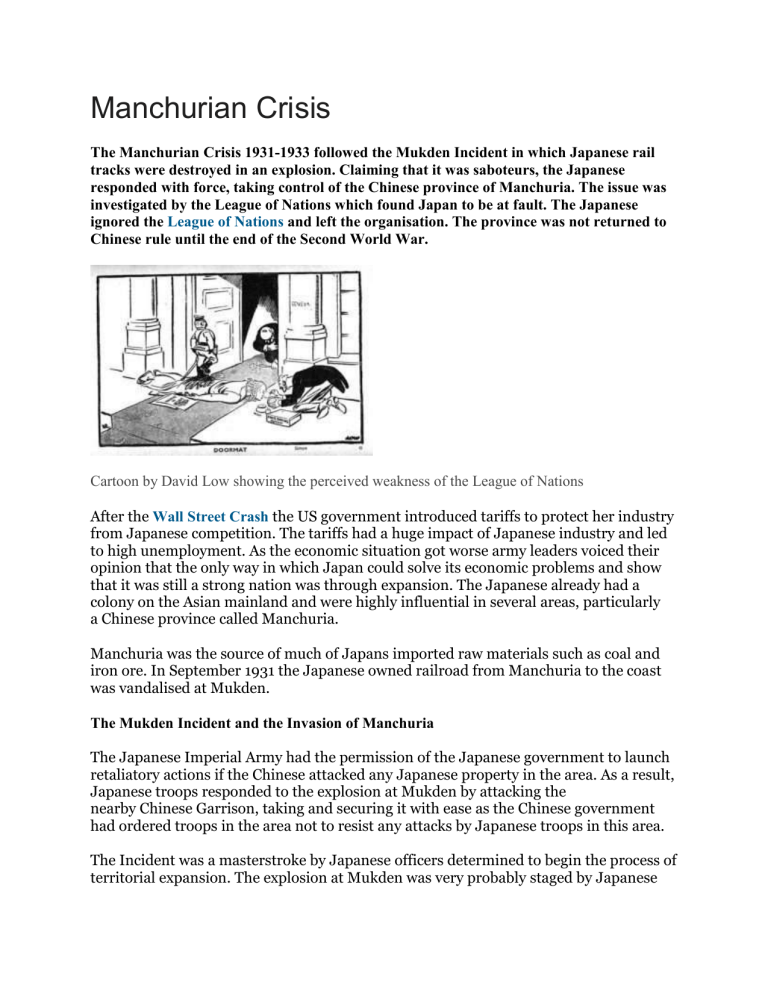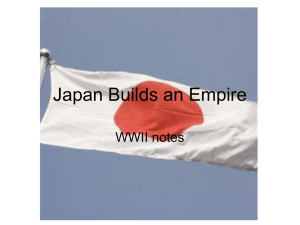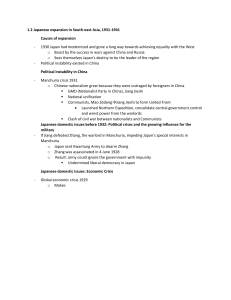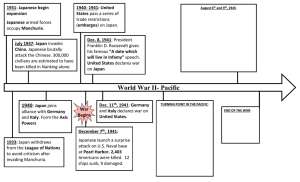
Manchurian Crisis The Manchurian Crisis 1931-1933 followed the Mukden Incident in which Japanese rail tracks were destroyed in an explosion. Claiming that it was saboteurs, the Japanese responded with force, taking control of the Chinese province of Manchuria. The issue was investigated by the League of Nations which found Japan to be at fault. The Japanese ignored the League of Nations and left the organisation. The province was not returned to Chinese rule until the end of the Second World War. Cartoon by David Low showing the perceived weakness of the League of Nations After the Wall Street Crash the US government introduced tariffs to protect her industry from Japanese competition. The tariffs had a huge impact of Japanese industry and led to high unemployment. As the economic situation got worse army leaders voiced their opinion that the only way in which Japan could solve its economic problems and show that it was still a strong nation was through expansion. The Japanese already had a colony on the Asian mainland and were highly influential in several areas, particularly a Chinese province called Manchuria. Manchuria was the source of much of Japans imported raw materials such as coal and iron ore. In September 1931 the Japanese owned railroad from Manchuria to the coast was vandalised at Mukden. The Mukden Incident and the Invasion of Manchuria The Japanese Imperial Army had the permission of the Japanese government to launch retaliatory actions if the Chinese attacked any Japanese property in the area. As a result, Japanese troops responded to the explosion at Mukden by attacking the nearby Chinese Garrison, taking and securing it with ease as the Chinese government had ordered troops in the area not to resist any attacks by Japanese troops in this area. The Incident was a masterstroke by Japanese officers determined to begin the process of territorial expansion. The explosion at Mukden was very probably staged by Japanese troops to enable a retaliatory attack. Following the seizure of Mukden Japanese troops began occupying other towns and cities in the area. Within 5 months the whole of Manchuria was under the control of the Japanese army. The Chinese Response to the Invasion of Manchuria The policy of the Chinese Government at the time of the Mukden Incident was one of non resistance towards Japanese troops in this area. This was primarily because they wanted to concentrate their efforts on defeating Communism in China and securing a strong and stable government. As a consequence the small Japanese force of some 11,000 men were able to take control of much of Manchuria very easily, despite the presence of a quarter of a million Chinese troops in the area. The Lytton Commission was established by the League of Nations to investigate the explosions. Investigators are shown here at the blast point. In order to try and retain control of Manchuria the Chinese appealed to the League of Nations. In October the League of Nations passed a resolution saying that Japanese troops should withdraw and established a commission which would investigate the claims of both sides. The Japanese rejected the League of Nations resolution and insisted on direct negotiations with the Chinese Government. These negotiations failed and the Japanese proceeded, now against some resistance, to take control of the remainder of Manchuria. They then proceeded to launch an attack on the Chinese city of Shanghai which was outside of the area of Japanese economic control. The League of Nations response to the Manchurian Crisis The initial response of the League of Nations was to follow its pre-arranged process for arbitration. They listened to the complaints of the Chinese and the Japanese position and then the Council, minus the representatives of China and Japan, discussed the issue before coming up with a Resolution. In this case the resolution called for Japanese withdrawal from Manchuria whilst a Commission investigated the issue. The Japanese ignored the wishes of the League of Nations and continued to expand whilst negotiations and diplomatic efforts to solve the crisis continued. When the commission produced its report on Manchuria in October 1932 it stated that Japan should leave Manchuria. A Special Assembly of the League of Nations was then held to vote on the issue in February 1933. When the vote reiterated that Japan should leave Manchuria, the Japanese delegation simply walked out of the League of Nations, never to return. What happened next? According to the League of Nations rules the failure of Japan to comply with a resolution should have been followed by economic sanctions and / or collectivemilitary action to enforce the resolution. The League in this case however, did neither. Countries could not agree on what economic sanctions should be imposed and the major powers of Britain and France were unwilling to risk their armed forces in a conflict on the other side of the world. Moreover, such action may have placed British and French Colonies in the Far East at risk of attack. Manchuria IGCSE History 1. 1. Manchuria 2. 2. Manchuria • The Nationalist government of China led by Chiang Kai-shek was weak, corrupt and busy fighting the Communists. • Because of the Great Depression, Japan wanted to build an empire to secure supplies of raw materials. • The Japanese government was controlled by the army • China ruled Manchuria, but the Japanese army ran the railway there, and ruled in Korea. 3. 3. Manchuria 4. 4. Manchuria • Sept 1931: There was some vandalism on the Manchurian railway; Japan claimed the Chinese had sabotaged the railway. • They invaded Manchuria and set up the 'independent' (i.e. Japanese-controlled) state of Manchukuo under the former Emperor of China, Henry P'ui. • China appealed to the League. 5. 5. Manchuria • Dec 1931: the League appointed a commission led by Lord Lytton to investigate. • He did not go to Manchuria until April 1932 and did not report until October. • Oct 1932: Lytton's report stated that Japan was the aggressor and should leave. • 24 Feb 1933: The Assembly voted that Japan should leave Manchuria • Japan walked out of the meeting. 6. 6. Manchuria • Japan stayed in Manchuria. • The League could not agree economic sanctions or an arms sales ban. • In 1933 Japan resigned from the League, and invaded/ conquered Jehol (next to Manchuria). 7. 7. Manchuria A SPECTACULAR failure: 1. The Japanese continued to expand: • they kept Manchuria • they invaded Jehol in 1933 and China in 1937. 8. 8. Manchuria A SPECTACULAR failure: 2. The League was discredited/ Manchuria showed: • It was slow (the Lytton Report took almost a year) • A country could get its own way if it ignored it • ‘Collective security' was useless against big countries - especially during the Great Depression. • Even the great powers within the League (Japan was on the Council) were happy to ignore it. https://www.youtube.com/watch?v=4E6MhEQm88o&feature=emb_logo Manchurian Crisis 1931-33 In 1931, the Japanese Empire controlled the South Manchuria Railway. In the September the Japanese claimed that the Chinese had sabotaged the railway. Using this pretense the Japanese army invaded and over ran Manchuria with Japanese forces. They removed the Chinese defensive forces and renamed the area Manchukuo. In Manchukuo they created a puppet government which would do as Japan commanded. China appealed directly to the League of Nations for support in the matter, as part of their territory had been invaded by Japan. The League sent officials to Manchuria, but the journey was long, it took a significant amount of time for the officials to arrive. It was therefore, an entire year before the League was able to publish the report in to the situation in Manchuria. The report itself was detailed and declared that Japan was in the wrong. Japan should have then withdrawn from Manchuria, but instead decided it was going to continue the invasion of China. Japan’s argument was still one of self defence, and argued that it was necessary to protect itself from China. After the League voted to approve the report against Japan, Japan left the League, withdrawing its support. This removal of Japan was a major blow to the League. What remained attempted to enforce economic sanctions against Japan, but were hampered by the fact that the biggest trading partner was the United States, who were not in the League. Britain also undermined the efforts of the League in punishing Japan as it wanted to keep good relations with the Japanese. Everytime the League came close to decision it would be averted as the members did not want a war to happen. The only countries who could do something about Japan were the Soviet Union or America, as as neither of those were in the League, it was unlikely to happen. The Manchurian Crisis proved to international observers such as Italy and Germany that the League was powerless to stop international aggression Key Facts & Summary It was caused by the Japanese occupation of Manchuria, a Chinese territory. It occurred after the Japanese Rail Company in Manchuria was attacked and vandalised. Japan accused China of carrying out the attacks. However, it was argued that the Japanese carried out the attack on themselves to justify their occupation of Manchuria. The Mukden (or Mukden or Manchuria) incident took place on September 18, 1931, in South Manchuria. It occurred when a section of railroad belonging to the South Manchurian Railway Company of Japan, near Mukden (now Shenyang), was destroyed. This attack was planned by the Japanese fearing a unification of China under the leadership of the Kuomintang, perceived as a threat against the Japanese establishment in the region. The Japanese military accused the Chinese of perpetrating the attack, thus giving the pretext for the immediate invasion of southern Manchuria by Japanese troops. This resulted in the creation of the puppet state of Manchukuo a few months later, under the theoretical authority of the exemperor of China, Puyi. This "provoked" incident was not unique. Similar processes were used under the leadership of General Tanaka between the late 1920s and the invasion of the rest of China to try to justify Japanese expansionism in Asia. In China, this incident was known as the incident of 9.18, or Li Tiao Gou incident. After the Russo-Japanese War (1904 - 1905), the Japanese Empire replaced the Russian Empire as the dominant power in Manchuria. The Japanese policy on China was confrontational throughout the 1930s. Until the establishment of the Imperial Headquarters in 1937, the Japanese Kantogun Army had some independence in Manchuria and northern China, both concerning civilian government and military authority in Tokyo. At the time, Emperor Shōwa and his advisers debated whether they should conquer China militarily and establish a colonial-style power, or subjugate China economically. The Japanese government wanted to maintain the fragmentation of China, enabling them to deal with the different Chinese factions, which were in open conflict with each other. For example, Japan's intervention in the Jinan incident against the Kuomintang in its northern expedition in 1928 to prevent a unification of China. The Chinese strategy of the time followed a doctrine of non-resistance. The aggressive strategy of the relatively independent Japanese military authority in China, coupled with the Chinese government's non-resistance strategy, was most likely the trigger for the Mukden incident. Description The goal of the young Japanese officers in Manchuria was to give a pretext justifying the Japanese military invasion and the replacement of the Chinese government in the region by a Japanese or puppet government. They chose to sabotage a section of the railway near Liutaio Lake. This area did not yet have an official name and was of no military significance for either side, but it was eight hundred meters from the Chinese garrison of Beidaying, stationed under the command of the young Marshal Zhang Xueliang. The plan was for the explosion to attract the attention of Chinese troops and then blame them for it as a pretext for a formal Japanese invasion. To make the sabotage look more convincing as a Chinese attack on a Japanese transport system and thus mask their intervention as a legitimate measure of protection of a railway of industrial and economic importance, the Japanese named it the Liutaogou site, or Liu Xiao Qiao, which means Liutaio Trench and Liutaio Bridge. In reality, the site was only a portion of the railway on a section of flat land. The location of the explosion allowed for minimal damage (and therefore minimal repairs), in contrast to the consequences of choosing a bridge. It appeared that the direct initiative came from two officers, Colonel Seishirō Itagaki and Lieutenant Colonel Kanji Ishiwara of the Shimamoto Regiment, in charge of guarding the railroad, and sappers placed the explosives under the rails. At approximately 10:20 pm, on September 18, the charge was detonated. The explosion was minor, and only a 1.5-meter section on one side of the track was damaged. In fact, a train from Changchun passed over the very site of the explosion without any problem and reached Mukden at 22:30. Consequences Immediately after the explosion, the Japanese surrounded the nearby Chinese garrison and attacked the troops stationed there under the pretext that any Japanese property should be protected from the onslaught of Chinese troops. "There was no doubt that the Japanese government, faced with a fait accompli, was powerless. The prime minister explained to the ruler that he had ordered the Guandong army to return to its bases. For his part, the Minister of War, Minami, sent "a telegram to Mukden in which he approved the action [...] but also wished that the case did not take another scale". The Guandong army activists decided to override it, and it was on their own initiative that they launched the Changchun offensive on the 20th of the month, triggering the invasion of Manchuria. The military had prevailed over civil power, a situation that announced growing pressure of the military on civilians during the 1930s (assassination of the Prime Minister in 1932, coup attempt of 26 February 1936), until the Second World War. Within a few days, the three provinces of Heilongjiang, Jilin, and Liaoning (where Mukden is located) were taken by the Japanese. On November 20th a conference of the Chinese government was set up. The Guangzhou faction of the Kuomintang insisted that Chiang Kai-shek resign because of the failure in Manchuria and the lack of serious resistance from Chinese troops. Chiang resigned on December 15th. Sun Ke, son of Sun Yat-sen, took the post of President of the Republic of China and vowed to defend Jinzhou, another city of Liaoning, quickly lost in January 1932. "If there was no doubt that the conspirators launched the incident on their own initiative, the Japanese Government, and the Emperor himself, should not have delayed to consider the new situation in Manchuria with serenity" and to resume to their account the consequences of the invasion of Manchuria. On February 18 1932, the state of Manchukuo was proclaimed on the territory of Manchuria with Hsinking as its capital. Formally independent, it was in fact only a Japanese protectorate. The instigators of the operation were promoted, demonstrating that if the military conspirators had acted on their own initiative, they had done so in a larger Japanese context, favourable to a policy of power on the Asian continent. The Japanese empire pursued its expansionist policy in China, triggering in 1937 the second Sino-Japanese War and in 1939 a failed attack on pro-Soviet Mongolia at the Battle of Khalkhin Gol. The government of Manchukuo remained in place under Japanese administration until 15 August 1945, a few days after the outbreak of the Soviet invasion of Manchuria. Controversial Various opinions still exist today about who dropped the bomb in Mukden. An exhibition dedicated to the September 18 Mukden incident, presented by the Chinese in the city, indicates that the bomb was set off by the Japanese. The Yasukuni Shrine Museum in Tokyo, meanwhile, argues that the Chinese were responsible. The Columbia Encyclopedia states that the truth is unknown. That said, there are many indications that the Japanese Guandong Army was responsible. While most members of this army denied having planted the bomb, Major Hanaya confessed that the Japanese had made the plan and dropped the bomb. Modern time The government of the People's Republic of China declared September 18 "National Day of Humiliation". The PRC government opened a memorial in Shenyang that houses a historical exhibit on the Mukden Incident, inaugurated on September 18 1991. The exhibition mixes some historical pieces, including posters and documents, with a dramatic educational re-enactment of the event including the Japanese occupation that followed, the resistance of the Chinese partisans, and the final liberation. The last room is dedicated to the reconciliation of Japan and China. Japanese Premier Ryūtarō Hashimoto visited the museum in 1997and it is one of the main tourist attractions of Shenyang City.




